-
 House at 40 Church Street, Wakefield, Mass.
House at 40 Church Street, Wakefield, Mass. Photos show views of the house located at 40 Church Street on the south side of the street opposite the Hartshorne House. Built around 1804, the Federal style house is known as the Ebenezer Wiley house after its builder. The house was constructed from a tin shop which was located on the site.
-
 House at 3 Common Street, Wakefield, Mass.
House at 3 Common Street, Wakefield, Mass. Photos show views of the house located at 3 Common Street on the west side of the Upper Common. Built around 1855, the Italianate house is of wood frame construction. It was built by John Francis Hartshorne, the son of Colonel James Hartshorne who lived on nearby Church Street in the Hartshorne House.
-
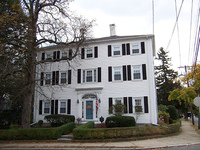 House at 34 Salem Street, Wakefield, Mass.
House at 34 Salem Street, Wakefield, Mass. Photos show views of the house located at 34 Salem Street on the southeast corner of the intersection with Pleasant Street. Built around 1819-1820, the large Federal style house was build by contractor Elias Boardman, who had also done construction work on Beacon Hill in Boston. The house was considered so extravagant at the time that it was known locally as "Boardman's Folly". A rear ell and garage were added later. The home is now broken into apartments.
-
 House at 34 Lafayette Street, Wakefield, Mass.
House at 34 Lafayette Street, Wakefield, Mass. Photos show views of the house located at 34 Lafayette Street on the south side of the street near the intersection with Church Street. Built around 1835, the Federal style house is of wood frame construction and has a Greek Revival style front porch which has a view of Lake Quannapowitt.
-
 House at 284 Main Street, Wakefield, Mass.
House at 284 Main Street, Wakefield, Mass. Photos show the house located at 284 Main Street at the corner of Park Street. Built in 1931, the house is of multicolored brick construction and faces the Upper Common.
-
 House at 266 Main Street, Wakefield, Mass.
House at 266 Main Street, Wakefield, Mass. Photos show the house located at 266 Main Street at the southeast corner of the interesection with Salem Street. Built in 1903, the five bedroom Queen Anne style house is of wood construction and overlooks the Common. It is now clad in vinyl siding.
-
 House at 25 Yale Avenue, Wakefield, Mass.
House at 25 Yale Avenue, Wakefield, Mass. Photos show views of the house located at 25 Yale Avenue on the north side of the street. Built around 1865, the home is a typical example of the Italianate style.
-
 House at 252 Main Street, Wakefield, Mass.
House at 252 Main Street, Wakefield, Mass. Photos show the house located at 252 Main Street. Built around 1818, the Federal style house is of brick construction and overlooks the Lower Common. The house was originally built for a member of the well-known Eaton family and has Rufus Porter murals on the living room walls.
-
 House at 24 Yale Avenue, Wakefield, Mass.
House at 24 Yale Avenue, Wakefield, Mass. Photos show views of the house located at 24 Yale Avenue on the south side of the street. Built around 1863, the Italianate and stick style house now houses legal offices. A carriage house and garage are located to the rear of the main home.
-
 House at 23 Lawrence Street, Wakefield, Mass.
House at 23 Lawrence Street, Wakefield, Mass. Photo shows the house located at 23 Lawrence Street at the corner of Pleasant Street. Built around 1890, the Colonial revival style house is of wood frame construction and has a garage and barn.
-
 House at 21 Yale Avenue, Wakefield, Mass.
House at 21 Yale Avenue, Wakefield, Mass. Photos show views of the house located at 21 Yale Avenue on the north side of the street. Built around 1870, the house is of wood frame construction and is a good example of the Queen Anne style.
-
 House at 21 Chestnut Street, Wakefield, Mass.
House at 21 Chestnut Street, Wakefield, Mass. Photos show views of the house located at 21 Chestnut Street on the north side of the street. Built around 1850, the Italianate house is of wood frame construction and was once owned by Frank and Ruth Woodbury, who were active in town history and affairs. The house was designed by architect John Stevens.
-
 House at 1 Common Street, Wakefield, Mass.
House at 1 Common Street, Wakefield, Mass. Photos show views of the house located at 1 Common Street on the west side of the Upper Common. Built between 1812 and 1820, the Federal style house now houses legal offices. A garage and outbuilding are located in the rear. 7. ;
-
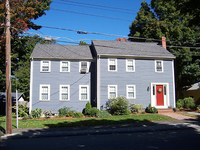 House at 15 Eaton Street, Wakefield, Mass.
House at 15 Eaton Street, Wakefield, Mass. Photos show views of the house located at 15 Eaton Street on the north side of the street. Built in 1840, the house is of wood frame construction and has several additions.
-
 Building at 13-15 Albion Street, Wakefield, Mass.
Building at 13-15 Albion Street, Wakefield, Mass. Photos show views of the building located at 13-15 Albion Street on the north side of the street. Built around 1906, the yellow brick building has businesses on the ground floor and apartments above. It is in Renaissance revival style and has four copper-clad bay windows on the upper floors.
-
 House at 120 Main Street, Wakefield, Mass.
House at 120 Main Street, Wakefield, Mass. Photos show views of the house formerly located at 120 Main Street facing Lake Quannapowitt. The house was built around 1948 and was of wood construction with a brick exterior. The front of the house had a large portico with four Ionic columns. The home was demolished in December 2007 to make way for a 12-lot subdivision called Carriage Lane.
-
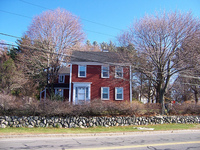 House at 114 Main Street, Wakefield, Mass.
House at 114 Main Street, Wakefield, Mass. Photos show views of the house located at 114 Main Street facing Lake Quannapowitt. Built before 1750, the house is of wood frame construction and was built by Dr. Thomas Simpson.
-
 Most Blessed Sacrament Roman Catholic Church at 1155 Main Street, Wakefield, Mass.
Most Blessed Sacrament Roman Catholic Church at 1155 Main Street, Wakefield, Mass. Photos show views of the Most Blessed Sacrament Catholic Church at 1155 Main Street on the west side of the street opposite Coolidge Park in the Greenwood section of Wakefield. After holding Masses for years at the local fire station, Catholics in the Greenwood section of Wakefield succeeded in raising enough money to build a proper chapel, where the first Mass was celebrated in the Shingle Style church in 1927. It remained a "mission" church of St. Joseph's until 1931, when a new parish was announced including Greenwood and parts of Melrose and Saugus. The wings were added in the 1940s and the building was expanded further in the late 20th century.
-
 House at 12 Salem Street, Wakefield, Mass.
House at 12 Salem Street, Wakefield, Mass. Photos show the house located at 12 Salem Street on the south side of the street near the Common. Built between 1831 and 1873, the Federal style house has an Italianate porch which was probably added in the 1860s or 1870s. In 1874 it was the home of Daniel Swett.
-
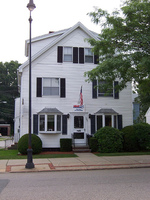 Building at 306 Main Street, Wakefield, Mass.
Building at 306 Main Street, Wakefield, Mass. Photos show views of the building located at 306 Main Street on the east side of the street at the corner of Crescent Street. The building also incorporates 1 Crescent Street. It was originally built as a shoe factory around 1800 by Benjamin Wiley, who later built the adjacent brick house in 1822. He converted this building to his home in 1850 after selling the brick house to his son Ebenezer. It is currently used for professional offices and apartments.
-
 Montrose drive-in, Wakefield, Mass.
Montrose drive-in, Wakefield, Mass. Photo shows the Montrose drive-in restaurant and ice cream stand, also known as the Montrose dairy, located on Salem Street opposite Audubon Road. The building was demolished in September 2007 to make way for a Dunkin Donuts.
-
 Train station, North Avenue, Wakefield, Mass.
Train station, North Avenue, Wakefield, Mass. Photo shows the MBTA railroad depot between North Avenue and Tuttle Street in Wakefield. The building opened in 1890 and was known as the Upper Depot. For many years the brick structure was painted red, but in 2006 it was repainted with the current Victorian era color scheme. It now contains office and business space.
-
 Most Blessed Sacrament Roman Catholic Church, Wakefield, Mass.
Most Blessed Sacrament Roman Catholic Church, Wakefield, Mass. Photo shows Most Blessed Sacrament Roman Catholic Church at 1155 Main Street in the Greenwood section of Wakefield. Th church was built in the shingle style in 1927 and has been enlarged since then.
-
 St. Florence's Roman Catholic Church, Wakefield, Mass.
St. Florence's Roman Catholic Church, Wakefield, Mass. Photo shows Saint Florence's Roman Catholic Church at 47 Butler Avenue. The church was built in 1960.
-
 Studio School, Wakefield, Mass.
Studio School, Wakefield, Mass. Photo shows the Studio School in Wakefield.
-
 Warren School/McCarthy Senior Center, Wakefield, Mass.
Warren School/McCarthy Senior Center, Wakefield, Mass. Photo shows the Warren School at 30 Converse Street on the West Side of Wakefield. The school was built in 1895, and now houses the town's senior center, run by the Wakefield Council on Aging.
-
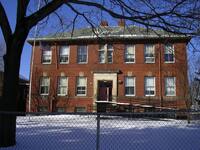 Hurd School, Wakefield, Mass.
Hurd School, Wakefield, Mass. Photo shows the Hurd School on the northwest corner of Cordis and Pleasant Streets in the North Ward section of Wakefield. The school was built in 1898. It closed in the early 2000s.
-
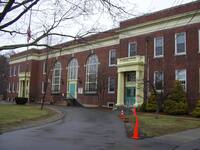 Greenwood School, Wakefield, Mass.
Greenwood School, Wakefield, Mass. Photo shows the Greenwood School on the east side of Main Street, number 1030 in the Greenwood section of Wakefield. The school was built in 1897, and remodeled and enlarged in 1902 and again in 1924.
-
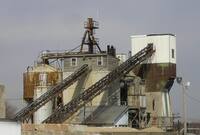 Wakefield Ready Mixed Concrete Company, Wakefield, Mass.
Wakefield Ready Mixed Concrete Company, Wakefield, Mass. Photo depicts the Wakefield Ready Mixed Concrete Company plant located at 1 New Salem Street.
-
 Greenwood Pharmacy, Wakefield, Mass.
Greenwood Pharmacy, Wakefield, Mass. Photo depicts the Greenwood Pharmacy located at 949 Main Street. The pharmacy was owned by the Velardo family for over 50 years at that location. It closed on Wednesday, December 26, 2007.
-
 Wakefield Bowladrome, Wakefield, Mass.
Wakefield Bowladrome, Wakefield, Mass. Photo depicts the Wakefield Bowladrome located at 92 Water Street.
-
 West Ward School, Wakefield, Mass.
West Ward School, Wakefield, Mass. The West Ward School, also known as the "Little Red Schoolhouse", was built in 1847. It is located on Prospect Street at the intersection with Elm Street.
-
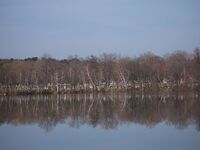 Lakeside Cemetery, Wakefield, Mass.
Lakeside Cemetery, Wakefield, Mass. Photo shows a view of Lakeside Cemetery on North Avenue, on the west shore of Lake Quannapowitt. This view was taken from the eastern shore of the Lake, near the intersection of Main and Sweetser Streets. The cemetery was established in 1846, and its Gothic chapel was built in 1932. After several land acquisitions, the cemetery is now about 22 acres in size.
-
 William Hescy headstone, Old Burying Ground, Wakefield, Mass.
William Hescy headstone, Old Burying Ground, Wakefield, Mass. Photo shows the William Hescy grave stone in the Old Burying Ground on Church Street. The stone is located at the west end of the cemetery.
-
 William Green headstone, Old Burying Ground, Wakefield, Mass.
William Green headstone, Old Burying Ground, Wakefield, Mass. Photo shows the William Green grave stone in the Old Burying Ground on Church Street. The stone is located at the east end of the cemetery
-
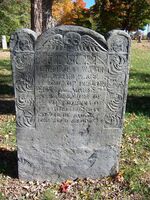 Thomas Parker headstone, Old Burying Ground, Wakefield, Mass.
Thomas Parker headstone, Old Burying Ground, Wakefield, Mass. Photo shows the Thomas Parker grave stone in the Old Burying Ground on Church Street. The stone is located at the west end of the cemetery.
-
 Matthew Edwardes headstone, Old Burying Ground, Wakefield, Mass.
Matthew Edwardes headstone, Old Burying Ground, Wakefield, Mass. Photo shows the Matthew Edwardes grave stone in the Old Burying Ground on Church Street. The stone is located at the east end of the cemetery.
-
 Sarah Briant [i. e. Bryant] headstone, Old Burying Ground, Wakefield, Mass.
Sarah Briant [i. e. Bryant] headstone, Old Burying Ground, Wakefield, Mass. Photo shows the Sarah Briant grave stone in the Old Burying Ground on Church Street.
-
 Elizabeth Browne headstone, Old Burying Ground, Wakefield, Mass.
Elizabeth Browne headstone, Old Burying Ground, Wakefield, Mass. Photo shows the Elizabeth Browne grave stone in the Old Burying Ground on Church Street. The stone is located at the west end of the cemetery.
-
 Thomas Kendel [i. e. Kendall] headstone, Old Burying Ground, Wakefield, Mass.
Thomas Kendel [i. e. Kendall] headstone, Old Burying Ground, Wakefield, Mass. Photo shows the Deacon Thomas Kendel grave stone in the Old Burying Ground on Church Street. The slate headstone was carved by the "Charlestown Carver", and is considered one of the earliest and best examples of Puritan cemetery carving in New England. Various sources date the stone to 1678, although others record Kendall's death in 1684.
-
 House at 21 Park Avenue, Wakefield, Mass.
House at 21 Park Avenue, Wakefield, Mass. Photo shows the house located at 21 Park Avenue on the north side of the street near Dell Avenue. The house is in the Wakefield Park neighborhood, the development of which began in 1886. The area was promoted as having a healthful and beautiful environment, with elegant homes and building restrictions.
-
 View of Centre Street looking west, 2007
View of Centre Street looking west, 2007 Photo shows a view of Centre Street looking west from Crescent Street towards Main Street. On the left is the 2004 Public Safety Building. In the middle ground the rear of CVS pharmacy can be seen on the left, and the rear of Alano department store on the right. In the far distance, on Main Street the tops of the Bourdon (Kingman) Block and Sovereign Bank are visible.
-
 View of Princess Street looking west, 2007
View of Princess Street looking west, 2007 Photo shows a view of Princess Street (originally Mechanic Street) looking west from Crescent Street towards Main Street. On the right is the 2004 Public Safety Building, with the 1891 brick hose drying tower visible.
-
 Wakefield Municipal Gas & Light Department building
Wakefield Municipal Gas & Light Department building Photo shows a view of the building housing the offices of the Wakefield Municipal Gas & Light Department, located at 9 Albion Street on the north side of the street. The brick building was built for the Wakefield Post Office in 1924 and used by them until 1937. The WMGLD purchased it in 1947.
-
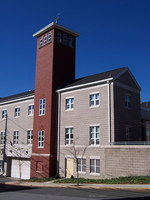 Hose drying tower, Public Safety Building, Wakefield, Mass.
Hose drying tower, Public Safety Building, Wakefield, Mass. Photo shows the brick hose drying tower, originally part of the 1891 central fire station at the corner of Crescent and Princess Streets. The tower was the only part of the building that was saved and incorporated into the new Public Safety Building, housing both the police and fire departments, which opened March 31, 2004.
-
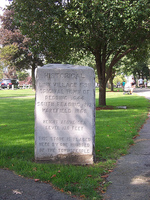 Historical marker, Wakefield, Mass.
Historical marker, Wakefield, Mass. Photo shows a view of the granite historical marker located at the extreme south end of the Upper Common. "Historical Linn Village 1639, Original town of Redding 1644, South Reading 1812, Wakefield 1868, Height above sea level 120 feet, This stone is placed here by one hundred of the townspeople A. D. 1909" - text from south (front) side of monument.
-
 Wakefield Town Hall, corner of Main and Water Streets, Wakefield, Mass.
Wakefield Town Hall, corner of Main and Water Streets, Wakefield, Mass. This photo mashup shows Main Street looking north from Water Street. The impressive building on the corner is Wakefield's original town hall, built with funds donated by Cyrus Wakefield. The structure was completed in 1871, and in gratitude to Cyrus, the townspeople decided to change the town's name in his honor from South Reading to Wakefield. Unfortunately, this magnificent building was damaged by fire in 1950, and after several years of debate, the town decided to demolish it rather than restore it. It was torn down in 1958 and the site is now a parking lot.
-
 Wakefield Upper Depot at 27-29 Tuttle Street, Wakefield, Mass.
Wakefield Upper Depot at 27-29 Tuttle Street, Wakefield, Mass. Photo mashup shows the railroad station on Tuttle Street, adjacent to North Avenue.
-
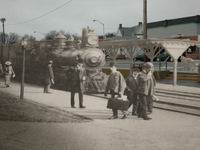 Wakefield Upper Depot at 27-29 Tuttle Street, Wakefield, Mass.
Wakefield Upper Depot at 27-29 Tuttle Street, Wakefield, Mass. Photo mashup shows the railroad station on Tuttle Street, adjacent to North Avenue.
-
 Lincoln School, Wakefield, Mass.
Lincoln School, Wakefield, Mass. Photo mashup shows the Lincoln School on Crescent Street, now housing for the elderly. The image is mashed up with a photo of the same area in 2011.
-
 "Kennedy for Senator," Main Street, Wakefield, Mass.
"Kennedy for Senator," Main Street, Wakefield, Mass. Photo mashup shows the business district on Main Street near Richardson Avenue looking east. A banner hangs over the street advertising John F. Kennedy's campaign for Senate, indicating the photo is from 1952. The image is mashed up with a photo of the same area in 2011.
-
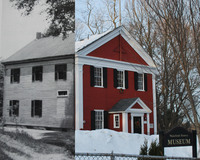 West Ward schoolhouse
West Ward schoolhouse Original photo from "Wakefield : 350 years by the lake." Current photo taken by Mary Anne Power, 2011.
-
 Joan Gerry in front of the Soldiers and Sailors Monument, Wakefield, Mass
Joan Gerry in front of the Soldiers and Sailors Monument, Wakefield, Mass These photo mashups show Joan Gerry, who posed as a child astride one of the cannons at the foot of the Soldiers and Sailors Monument, which was erected on the Upper Common in 1902 to commemorate Wakefield's involvement in the Civil War. Joan posed again in 2011 in the same spot, standing behind the same cannon, allowing us to switch the child and the adult in each photo.
-
 Wakefield Town Hall, corner of Main and Water Streets, Wakefield, Mass.
Wakefield Town Hall, corner of Main and Water Streets, Wakefield, Mass. Original photo of Town Hall from 1947 by Alfred Mellett. Current photo taken by Jeff Klapes, 2011.
-
 Wakefield Town Hall at 1 Lafayette Street, Wakefield, Mass.
Wakefield Town Hall at 1 Lafayette Street, Wakefield, Mass. Original photo of Town Hall taken in 1897 when the building was still used as a school. Current photo taken by Jeff Klapes, 2011.
-
 Lake Quannapowitt
Lake Quannapowitt Original photo of south shore of Lake Quannapowitt with dock. Current photo taken by Emma Kraus, 2011.
-
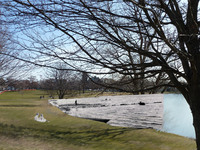 Lake Quannapowitt
Lake Quannapowitt Original photo of south shore of Lake Quannapowitt. Current photo taken by Emma Kraus, 2011.
-
 Church Street looking east, Wakefield, Mass.
Church Street looking east, Wakefield, Mass. Original photo taken sometime in the first decade of the 20th century. Current photo taken by Doug Heath, 2011.
-
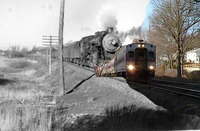 Wakefield trains
Wakefield trains Original photo taken by Joseph Payro on December 24, 1939 shows a locomotive heading south towards Melrose along the shore of Crystal Lake in Greenwood. Current photo taken by Cole Kraus, 2011.
-
 Baseball on Wakefield Common
Baseball on Wakefield Common Original image of Wakefield Common from a 1921 postcard mashed up with photo by Annette Dupon, 2011.
-
 Wakefield Post Office
Wakefield Post Office Historical image of Wakefield Post Office (Richardson Building) from the early 1900's mashed up with photo by Annette Dupon of Wakefield Post office back room, 2011.
-
 YMCA and Baptist church
YMCA and Baptist church "I like this picture and copied it because it's next to Yale Ave where I live. The town hall has changed a lot but the rest looks the same." - caption provided by Sofia Bruce (age 7), contest winner.
-
 Wakefield YMCA building
Wakefield YMCA building "Attached is my photo from February of the old YMCA building, when Artichokes had the "Christmas Tree" decorated for Valentine's Day. I was happy that the renovations into Artichokes and condos didn't change the look of the front of the building much, as it is such a part of downtown Wakefield. I went in for dinner one night a few months ago, and opened the door half expecting to smell chlorine from the pool." - caption provided by Mary Anne Power, contest winner.
-
 The Isaac Green House
The Isaac Green House "This venerable old home has undergone renovations and improvements but is still quite recognizable from the early image. It stands in its neighborhood as a symbol of growth and progress within a context of stability and timelessness." - caption provided by Loren Hill, contest winner.
-
 The Rockery
The Rockery "The unique rock structure on Main Street honored local town history. It was inviting, almost pastoral, as illustrated by the young lad and his relaxed pose. Today the area is less inviting. No crosswalks connect to any sidewalks on Main Street. Traffic swirls around it like a swarm of angry hornets. The stone marker noting local towns has been moved elsewhere to a less prominent spot on the town common. In its stead is the statue of a military figure commemorating the Spanish-American War. Today's 'Young lad' must brave heavy traffic to visit the island on Main Street." - caption provided by Loren Hill, contest winner.
-
 YMCA and Baptist church
YMCA and Baptist church "The reason I chose to take a now picture of the YMCA is because of how much the YMCA has been involved in my life during my childhood. Since I moved to Wakefield in the 2nd grade my mom has sent me and my sister to the YMCA to be watched after while she went to work. While we were there we formed many great friendships and many lasting memories. The YMCA was a place where I spent most of my childhood and it still amazes me and the change it went through." - caption provided by Julia MacDonald, contest winner.
-
 Upham House, Main Street at Crystal Lake
Upham House, Main Street at Crystal Lake "I walk my dog past this house all the time. I chose this photo because it was one of the only photos that did not change much." - caption provided by Emma Kraus, contest winner.
-
 Crystal Lake from Harts Hill
Crystal Lake from Harts Hill "The reason I chose this photo is because I live across the street from J.J. Round Park. It was so beautiful until people wrote graffiti all over the rocks and smashed beer bottles. Trees grew in back of the rock so you can't see the houses on Main Street anymore. You can see the water plant in the right hand corner of the photo. It is still a nice view of Crystal Lake" - caption provided by Emma Kraus, contest winner.
-
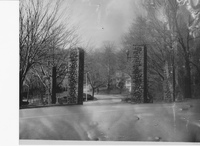 Wakefield Park stone entrance gate
Wakefield Park stone entrance gate "Attached is my entry for the "Then and Now" contest. I chose "Park Gates -- Wakefield, Massachusetts" for my subject. The gates on Chestnut Street form the entrance to Wakefield Park, on the west side of town. I have been interested in the Park's history since moving here in the mid-1990's. The land was originally owned by Dr. Charles Jordan and consisted largely of pastureland and orchards. In the early 1890's, Boston lawyer Charles Stedman Hanks and J. S. Merrill developed the 100-acre property to attract upper middle-class residents. Wakefield Park may have been the first planned suburban development in the United States, and is still a very attractive place to live. I took my photograph using a late 19-century technique, probably similar to the one used to take the original picture. I made the contact print from a 10" X 12" glass negative that I exposed with a 100-year old camera and brass lens. To make the negative, I poured a silver-gelatine emulsion gently on a glass plate to form a smooth coating, and allowed it to dry. I exposed the plate for 8 seconds about 10 a.m. on March 24th, 2010 from the same position and approximate time of day as the original. Comparing the two photographs, changes over the past 120 years are apparent. The original Park Avenue was unpaved and much narrower than it is now. The building slightly visible on the right was moved across Park Avenue sometime before the Emmanuel Temple was built. The house that appears between the gates had a second floor added in the 1970's according to its current owner. In addition, all electric lines have since been put underground." - caption provided by Doug Heath, contest winner.
-
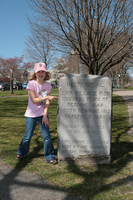 The Rockery
The Rockery "As Sofia and I walked around town, taking pictures for the Library's Wakefield Then & Now Photo Contest, I thought of the original picture postcard of The Rockery, postmarked 1914, with a young boy in his coat and cap posed near the historical marker. Today, The Rockery has become a monument to the Spanish-American war and the historical marker has been moved across the street to the upper common. I marvel at the changes this boy must have seen over his lifetime, not only the physical differences in roads, houses, and buildings, but also the things that science and technology have brought to our day: modern medicine, radio, television, the internet. I wonder at things Sofia and those who come after her will see in their lifetimes. Will they be as different from our present time as we are from the little boy on The Rockery?" - caption provided by David Bruce, contest winner.
-
 The Rockery
The Rockery "As Sofia and I walked around town, taking pictures for the Library's Wakefield Then & Now Photo Contest, I thought of the original picture postcard of The Rockery, postmarked 1914, with a young boy in his coat and cap posed near the historical marker. Today, The Rockery has become a monument to the Spanish-American war and the historical marker has been moved across the street to the upper common. I marvel at the changes this boy must have seen over his lifetime, not only the physical differences in roads, houses, and buildings, but also the things that science and technology have brought to our day: modern medicine, radio, television, the internet. I wonder at things Sofia and those who come after her will see in their lifetimes. Will they be as different from our present time as we are from the little boy on The Rockery?" - caption provided by David Bruce, contest winner.
-
 Corner of Water Street and Wakefield Avenue
Corner of Water Street and Wakefield Avenue "I thought the buildings might be torn down or reconstructed, but the buildings were still there but different colors and the stores have changed owners. In the original photo, two women and one man were walking. Since there were no people walking by, I had my mother, sister and our friend stand so it would look like the original photo. You can see that the clothes they wore were different than those we wear now. It helps tell the age of the photo by the car parked on the side of the street. Cars have changed a lot since that photo was taken." - caption provided by Cole Kraus (age 10), contest winner.
-
 Wakefield rattan factories on Water Street
Wakefield rattan factories on Water Street "No longer standing are the historic buildings that the founder of our town used for many years as rattan factories. The open space that once had cows roaming in the foreground now remains somewhat open in the form of two baseball fields and a small playground. The brook remains and runs alongside the park and crosses under Water Street under a small bridge. It was difficult to get the same vantage point. The distinct rooftop of Lincoln School in the distant top right let me know I was photographing in the right direction." - caption provided by Annette Dupon, contest winner.;Winner of photo contest, Second Place, Adult category.
-
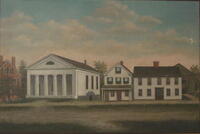 Universalist Church, Wakefield in 1858
Universalist Church, Wakefield in 1858
-
 Lakeside, Wakefield in 1870
Lakeside, Wakefield in 1870
-
 East side, Main St., in 1858
East side, Main St., in 1858
-
 Wakefield rattan works in 1865
Wakefield rattan works in 1865
-
 Yale Ave. to Lafayette St., South Reading, Mass., 1865
Yale Ave. to Lafayette St., South Reading, Mass., 1865
-
 Wiley's boathouse
Wiley's boathouse
-
 Wide horizons
Wide horizons
-
 [Wakefield Park stone entrance gate]
[Wakefield Park stone entrance gate]
-
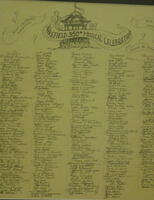 Wakefield 350th musical celebration June 18, 1994
Wakefield 350th musical celebration June 18, 1994
-
 Town Hall and fire engine house, Church St., South Reading, 1852
Town Hall and fire engine house, Church St., South Reading, 1852
-
 [Stone wall in woods]
[Stone wall in woods]
-
 South Reading, Mass., from Hart's Hill, 1866
South Reading, Mass., from Hart's Hill, 1866
-
 [Reedy Meadow]
[Reedy Meadow]
-
 [Railroad shack corner of Forest and Main Streets]
[Railroad shack corner of Forest and Main Streets]
-
 [Quannapowitt Yacht Club]
[Quannapowitt Yacht Club]
-
 Quannapowitt House
Quannapowitt House
-
 [Old Nahant Road]
[Old Nahant Road]
-
 [Old Burying Ground]
[Old Burying Ground]
-
 "Old Band Stand " in 1873 looking so. west
"Old Band Stand " in 1873 looking so. west
-
 Main Street,Wakefield in 1857
Main Street,Wakefield in 1857
-
 Lucius Morris Beebe and T-Bone Towser
Lucius Morris Beebe and T-Bone Towser
-
 Lucius Morris Beebe
Lucius Morris Beebe
-
 Lucius Beebe
Lucius Beebe
-
 Library at Wakefield, Mass.
Library at Wakefield, Mass.
-
 L'amour a l'arc
L'amour a l'arc
-
 Junius Oliver Beebe 1894-1933
Junius Oliver Beebe 1894-1933
-
 Junius Beebe
Junius Beebe
 House at 40 Church Street, Wakefield, Mass. Photos show views of the house located at 40 Church Street on the south side of the street opposite the Hartshorne House. Built around 1804, the Federal style house is known as the Ebenezer Wiley house after its builder. The house was constructed from a tin shop which was located on the site.
House at 40 Church Street, Wakefield, Mass. Photos show views of the house located at 40 Church Street on the south side of the street opposite the Hartshorne House. Built around 1804, the Federal style house is known as the Ebenezer Wiley house after its builder. The house was constructed from a tin shop which was located on the site. House at 3 Common Street, Wakefield, Mass. Photos show views of the house located at 3 Common Street on the west side of the Upper Common. Built around 1855, the Italianate house is of wood frame construction. It was built by John Francis Hartshorne, the son of Colonel James Hartshorne who lived on nearby Church Street in the Hartshorne House.
House at 3 Common Street, Wakefield, Mass. Photos show views of the house located at 3 Common Street on the west side of the Upper Common. Built around 1855, the Italianate house is of wood frame construction. It was built by John Francis Hartshorne, the son of Colonel James Hartshorne who lived on nearby Church Street in the Hartshorne House. House at 34 Salem Street, Wakefield, Mass. Photos show views of the house located at 34 Salem Street on the southeast corner of the intersection with Pleasant Street. Built around 1819-1820, the large Federal style house was build by contractor Elias Boardman, who had also done construction work on Beacon Hill in Boston. The house was considered so extravagant at the time that it was known locally as "Boardman's Folly". A rear ell and garage were added later. The home is now broken into apartments.
House at 34 Salem Street, Wakefield, Mass. Photos show views of the house located at 34 Salem Street on the southeast corner of the intersection with Pleasant Street. Built around 1819-1820, the large Federal style house was build by contractor Elias Boardman, who had also done construction work on Beacon Hill in Boston. The house was considered so extravagant at the time that it was known locally as "Boardman's Folly". A rear ell and garage were added later. The home is now broken into apartments. House at 34 Lafayette Street, Wakefield, Mass. Photos show views of the house located at 34 Lafayette Street on the south side of the street near the intersection with Church Street. Built around 1835, the Federal style house is of wood frame construction and has a Greek Revival style front porch which has a view of Lake Quannapowitt.
House at 34 Lafayette Street, Wakefield, Mass. Photos show views of the house located at 34 Lafayette Street on the south side of the street near the intersection with Church Street. Built around 1835, the Federal style house is of wood frame construction and has a Greek Revival style front porch which has a view of Lake Quannapowitt. House at 284 Main Street, Wakefield, Mass. Photos show the house located at 284 Main Street at the corner of Park Street. Built in 1931, the house is of multicolored brick construction and faces the Upper Common.
House at 284 Main Street, Wakefield, Mass. Photos show the house located at 284 Main Street at the corner of Park Street. Built in 1931, the house is of multicolored brick construction and faces the Upper Common. House at 266 Main Street, Wakefield, Mass. Photos show the house located at 266 Main Street at the southeast corner of the interesection with Salem Street. Built in 1903, the five bedroom Queen Anne style house is of wood construction and overlooks the Common. It is now clad in vinyl siding.
House at 266 Main Street, Wakefield, Mass. Photos show the house located at 266 Main Street at the southeast corner of the interesection with Salem Street. Built in 1903, the five bedroom Queen Anne style house is of wood construction and overlooks the Common. It is now clad in vinyl siding. House at 25 Yale Avenue, Wakefield, Mass. Photos show views of the house located at 25 Yale Avenue on the north side of the street. Built around 1865, the home is a typical example of the Italianate style.
House at 25 Yale Avenue, Wakefield, Mass. Photos show views of the house located at 25 Yale Avenue on the north side of the street. Built around 1865, the home is a typical example of the Italianate style. House at 252 Main Street, Wakefield, Mass. Photos show the house located at 252 Main Street. Built around 1818, the Federal style house is of brick construction and overlooks the Lower Common. The house was originally built for a member of the well-known Eaton family and has Rufus Porter murals on the living room walls.
House at 252 Main Street, Wakefield, Mass. Photos show the house located at 252 Main Street. Built around 1818, the Federal style house is of brick construction and overlooks the Lower Common. The house was originally built for a member of the well-known Eaton family and has Rufus Porter murals on the living room walls. House at 24 Yale Avenue, Wakefield, Mass. Photos show views of the house located at 24 Yale Avenue on the south side of the street. Built around 1863, the Italianate and stick style house now houses legal offices. A carriage house and garage are located to the rear of the main home.
House at 24 Yale Avenue, Wakefield, Mass. Photos show views of the house located at 24 Yale Avenue on the south side of the street. Built around 1863, the Italianate and stick style house now houses legal offices. A carriage house and garage are located to the rear of the main home. House at 23 Lawrence Street, Wakefield, Mass. Photo shows the house located at 23 Lawrence Street at the corner of Pleasant Street. Built around 1890, the Colonial revival style house is of wood frame construction and has a garage and barn.
House at 23 Lawrence Street, Wakefield, Mass. Photo shows the house located at 23 Lawrence Street at the corner of Pleasant Street. Built around 1890, the Colonial revival style house is of wood frame construction and has a garage and barn. House at 21 Yale Avenue, Wakefield, Mass. Photos show views of the house located at 21 Yale Avenue on the north side of the street. Built around 1870, the house is of wood frame construction and is a good example of the Queen Anne style.
House at 21 Yale Avenue, Wakefield, Mass. Photos show views of the house located at 21 Yale Avenue on the north side of the street. Built around 1870, the house is of wood frame construction and is a good example of the Queen Anne style. House at 21 Chestnut Street, Wakefield, Mass. Photos show views of the house located at 21 Chestnut Street on the north side of the street. Built around 1850, the Italianate house is of wood frame construction and was once owned by Frank and Ruth Woodbury, who were active in town history and affairs. The house was designed by architect John Stevens.
House at 21 Chestnut Street, Wakefield, Mass. Photos show views of the house located at 21 Chestnut Street on the north side of the street. Built around 1850, the Italianate house is of wood frame construction and was once owned by Frank and Ruth Woodbury, who were active in town history and affairs. The house was designed by architect John Stevens. House at 1 Common Street, Wakefield, Mass. Photos show views of the house located at 1 Common Street on the west side of the Upper Common. Built between 1812 and 1820, the Federal style house now houses legal offices. A garage and outbuilding are located in the rear. 7. ;
House at 1 Common Street, Wakefield, Mass. Photos show views of the house located at 1 Common Street on the west side of the Upper Common. Built between 1812 and 1820, the Federal style house now houses legal offices. A garage and outbuilding are located in the rear. 7. ; House at 15 Eaton Street, Wakefield, Mass. Photos show views of the house located at 15 Eaton Street on the north side of the street. Built in 1840, the house is of wood frame construction and has several additions.
House at 15 Eaton Street, Wakefield, Mass. Photos show views of the house located at 15 Eaton Street on the north side of the street. Built in 1840, the house is of wood frame construction and has several additions. Building at 13-15 Albion Street, Wakefield, Mass. Photos show views of the building located at 13-15 Albion Street on the north side of the street. Built around 1906, the yellow brick building has businesses on the ground floor and apartments above. It is in Renaissance revival style and has four copper-clad bay windows on the upper floors.
Building at 13-15 Albion Street, Wakefield, Mass. Photos show views of the building located at 13-15 Albion Street on the north side of the street. Built around 1906, the yellow brick building has businesses on the ground floor and apartments above. It is in Renaissance revival style and has four copper-clad bay windows on the upper floors. House at 120 Main Street, Wakefield, Mass. Photos show views of the house formerly located at 120 Main Street facing Lake Quannapowitt. The house was built around 1948 and was of wood construction with a brick exterior. The front of the house had a large portico with four Ionic columns. The home was demolished in December 2007 to make way for a 12-lot subdivision called Carriage Lane.
House at 120 Main Street, Wakefield, Mass. Photos show views of the house formerly located at 120 Main Street facing Lake Quannapowitt. The house was built around 1948 and was of wood construction with a brick exterior. The front of the house had a large portico with four Ionic columns. The home was demolished in December 2007 to make way for a 12-lot subdivision called Carriage Lane. House at 114 Main Street, Wakefield, Mass. Photos show views of the house located at 114 Main Street facing Lake Quannapowitt. Built before 1750, the house is of wood frame construction and was built by Dr. Thomas Simpson.
House at 114 Main Street, Wakefield, Mass. Photos show views of the house located at 114 Main Street facing Lake Quannapowitt. Built before 1750, the house is of wood frame construction and was built by Dr. Thomas Simpson. Most Blessed Sacrament Roman Catholic Church at 1155 Main Street, Wakefield, Mass. Photos show views of the Most Blessed Sacrament Catholic Church at 1155 Main Street on the west side of the street opposite Coolidge Park in the Greenwood section of Wakefield. After holding Masses for years at the local fire station, Catholics in the Greenwood section of Wakefield succeeded in raising enough money to build a proper chapel, where the first Mass was celebrated in the Shingle Style church in 1927. It remained a "mission" church of St. Joseph's until 1931, when a new parish was announced including Greenwood and parts of Melrose and Saugus. The wings were added in the 1940s and the building was expanded further in the late 20th century.
Most Blessed Sacrament Roman Catholic Church at 1155 Main Street, Wakefield, Mass. Photos show views of the Most Blessed Sacrament Catholic Church at 1155 Main Street on the west side of the street opposite Coolidge Park in the Greenwood section of Wakefield. After holding Masses for years at the local fire station, Catholics in the Greenwood section of Wakefield succeeded in raising enough money to build a proper chapel, where the first Mass was celebrated in the Shingle Style church in 1927. It remained a "mission" church of St. Joseph's until 1931, when a new parish was announced including Greenwood and parts of Melrose and Saugus. The wings were added in the 1940s and the building was expanded further in the late 20th century. House at 12 Salem Street, Wakefield, Mass. Photos show the house located at 12 Salem Street on the south side of the street near the Common. Built between 1831 and 1873, the Federal style house has an Italianate porch which was probably added in the 1860s or 1870s. In 1874 it was the home of Daniel Swett.
House at 12 Salem Street, Wakefield, Mass. Photos show the house located at 12 Salem Street on the south side of the street near the Common. Built between 1831 and 1873, the Federal style house has an Italianate porch which was probably added in the 1860s or 1870s. In 1874 it was the home of Daniel Swett. Building at 306 Main Street, Wakefield, Mass. Photos show views of the building located at 306 Main Street on the east side of the street at the corner of Crescent Street. The building also incorporates 1 Crescent Street. It was originally built as a shoe factory around 1800 by Benjamin Wiley, who later built the adjacent brick house in 1822. He converted this building to his home in 1850 after selling the brick house to his son Ebenezer. It is currently used for professional offices and apartments.
Building at 306 Main Street, Wakefield, Mass. Photos show views of the building located at 306 Main Street on the east side of the street at the corner of Crescent Street. The building also incorporates 1 Crescent Street. It was originally built as a shoe factory around 1800 by Benjamin Wiley, who later built the adjacent brick house in 1822. He converted this building to his home in 1850 after selling the brick house to his son Ebenezer. It is currently used for professional offices and apartments. Montrose drive-in, Wakefield, Mass. Photo shows the Montrose drive-in restaurant and ice cream stand, also known as the Montrose dairy, located on Salem Street opposite Audubon Road. The building was demolished in September 2007 to make way for a Dunkin Donuts.
Montrose drive-in, Wakefield, Mass. Photo shows the Montrose drive-in restaurant and ice cream stand, also known as the Montrose dairy, located on Salem Street opposite Audubon Road. The building was demolished in September 2007 to make way for a Dunkin Donuts. Train station, North Avenue, Wakefield, Mass. Photo shows the MBTA railroad depot between North Avenue and Tuttle Street in Wakefield. The building opened in 1890 and was known as the Upper Depot. For many years the brick structure was painted red, but in 2006 it was repainted with the current Victorian era color scheme. It now contains office and business space.
Train station, North Avenue, Wakefield, Mass. Photo shows the MBTA railroad depot between North Avenue and Tuttle Street in Wakefield. The building opened in 1890 and was known as the Upper Depot. For many years the brick structure was painted red, but in 2006 it was repainted with the current Victorian era color scheme. It now contains office and business space. Most Blessed Sacrament Roman Catholic Church, Wakefield, Mass. Photo shows Most Blessed Sacrament Roman Catholic Church at 1155 Main Street in the Greenwood section of Wakefield. Th church was built in the shingle style in 1927 and has been enlarged since then.
Most Blessed Sacrament Roman Catholic Church, Wakefield, Mass. Photo shows Most Blessed Sacrament Roman Catholic Church at 1155 Main Street in the Greenwood section of Wakefield. Th church was built in the shingle style in 1927 and has been enlarged since then. St. Florence's Roman Catholic Church, Wakefield, Mass. Photo shows Saint Florence's Roman Catholic Church at 47 Butler Avenue. The church was built in 1960.
St. Florence's Roman Catholic Church, Wakefield, Mass. Photo shows Saint Florence's Roman Catholic Church at 47 Butler Avenue. The church was built in 1960. Studio School, Wakefield, Mass. Photo shows the Studio School in Wakefield.
Studio School, Wakefield, Mass. Photo shows the Studio School in Wakefield. Warren School/McCarthy Senior Center, Wakefield, Mass. Photo shows the Warren School at 30 Converse Street on the West Side of Wakefield. The school was built in 1895, and now houses the town's senior center, run by the Wakefield Council on Aging.
Warren School/McCarthy Senior Center, Wakefield, Mass. Photo shows the Warren School at 30 Converse Street on the West Side of Wakefield. The school was built in 1895, and now houses the town's senior center, run by the Wakefield Council on Aging. Hurd School, Wakefield, Mass. Photo shows the Hurd School on the northwest corner of Cordis and Pleasant Streets in the North Ward section of Wakefield. The school was built in 1898. It closed in the early 2000s.
Hurd School, Wakefield, Mass. Photo shows the Hurd School on the northwest corner of Cordis and Pleasant Streets in the North Ward section of Wakefield. The school was built in 1898. It closed in the early 2000s. Greenwood School, Wakefield, Mass. Photo shows the Greenwood School on the east side of Main Street, number 1030 in the Greenwood section of Wakefield. The school was built in 1897, and remodeled and enlarged in 1902 and again in 1924.
Greenwood School, Wakefield, Mass. Photo shows the Greenwood School on the east side of Main Street, number 1030 in the Greenwood section of Wakefield. The school was built in 1897, and remodeled and enlarged in 1902 and again in 1924. Wakefield Ready Mixed Concrete Company, Wakefield, Mass. Photo depicts the Wakefield Ready Mixed Concrete Company plant located at 1 New Salem Street.
Wakefield Ready Mixed Concrete Company, Wakefield, Mass. Photo depicts the Wakefield Ready Mixed Concrete Company plant located at 1 New Salem Street. Greenwood Pharmacy, Wakefield, Mass. Photo depicts the Greenwood Pharmacy located at 949 Main Street. The pharmacy was owned by the Velardo family for over 50 years at that location. It closed on Wednesday, December 26, 2007.
Greenwood Pharmacy, Wakefield, Mass. Photo depicts the Greenwood Pharmacy located at 949 Main Street. The pharmacy was owned by the Velardo family for over 50 years at that location. It closed on Wednesday, December 26, 2007. Wakefield Bowladrome, Wakefield, Mass. Photo depicts the Wakefield Bowladrome located at 92 Water Street.
Wakefield Bowladrome, Wakefield, Mass. Photo depicts the Wakefield Bowladrome located at 92 Water Street. West Ward School, Wakefield, Mass. The West Ward School, also known as the "Little Red Schoolhouse", was built in 1847. It is located on Prospect Street at the intersection with Elm Street.
West Ward School, Wakefield, Mass. The West Ward School, also known as the "Little Red Schoolhouse", was built in 1847. It is located on Prospect Street at the intersection with Elm Street. Lakeside Cemetery, Wakefield, Mass. Photo shows a view of Lakeside Cemetery on North Avenue, on the west shore of Lake Quannapowitt. This view was taken from the eastern shore of the Lake, near the intersection of Main and Sweetser Streets. The cemetery was established in 1846, and its Gothic chapel was built in 1932. After several land acquisitions, the cemetery is now about 22 acres in size.
Lakeside Cemetery, Wakefield, Mass. Photo shows a view of Lakeside Cemetery on North Avenue, on the west shore of Lake Quannapowitt. This view was taken from the eastern shore of the Lake, near the intersection of Main and Sweetser Streets. The cemetery was established in 1846, and its Gothic chapel was built in 1932. After several land acquisitions, the cemetery is now about 22 acres in size. William Hescy headstone, Old Burying Ground, Wakefield, Mass. Photo shows the William Hescy grave stone in the Old Burying Ground on Church Street. The stone is located at the west end of the cemetery.
William Hescy headstone, Old Burying Ground, Wakefield, Mass. Photo shows the William Hescy grave stone in the Old Burying Ground on Church Street. The stone is located at the west end of the cemetery. William Green headstone, Old Burying Ground, Wakefield, Mass. Photo shows the William Green grave stone in the Old Burying Ground on Church Street. The stone is located at the east end of the cemetery
William Green headstone, Old Burying Ground, Wakefield, Mass. Photo shows the William Green grave stone in the Old Burying Ground on Church Street. The stone is located at the east end of the cemetery Thomas Parker headstone, Old Burying Ground, Wakefield, Mass. Photo shows the Thomas Parker grave stone in the Old Burying Ground on Church Street. The stone is located at the west end of the cemetery.
Thomas Parker headstone, Old Burying Ground, Wakefield, Mass. Photo shows the Thomas Parker grave stone in the Old Burying Ground on Church Street. The stone is located at the west end of the cemetery. Matthew Edwardes headstone, Old Burying Ground, Wakefield, Mass. Photo shows the Matthew Edwardes grave stone in the Old Burying Ground on Church Street. The stone is located at the east end of the cemetery.
Matthew Edwardes headstone, Old Burying Ground, Wakefield, Mass. Photo shows the Matthew Edwardes grave stone in the Old Burying Ground on Church Street. The stone is located at the east end of the cemetery. Sarah Briant [i. e. Bryant] headstone, Old Burying Ground, Wakefield, Mass. Photo shows the Sarah Briant grave stone in the Old Burying Ground on Church Street.
Sarah Briant [i. e. Bryant] headstone, Old Burying Ground, Wakefield, Mass. Photo shows the Sarah Briant grave stone in the Old Burying Ground on Church Street. Elizabeth Browne headstone, Old Burying Ground, Wakefield, Mass. Photo shows the Elizabeth Browne grave stone in the Old Burying Ground on Church Street. The stone is located at the west end of the cemetery.
Elizabeth Browne headstone, Old Burying Ground, Wakefield, Mass. Photo shows the Elizabeth Browne grave stone in the Old Burying Ground on Church Street. The stone is located at the west end of the cemetery. Thomas Kendel [i. e. Kendall] headstone, Old Burying Ground, Wakefield, Mass. Photo shows the Deacon Thomas Kendel grave stone in the Old Burying Ground on Church Street. The slate headstone was carved by the "Charlestown Carver", and is considered one of the earliest and best examples of Puritan cemetery carving in New England. Various sources date the stone to 1678, although others record Kendall's death in 1684.
Thomas Kendel [i. e. Kendall] headstone, Old Burying Ground, Wakefield, Mass. Photo shows the Deacon Thomas Kendel grave stone in the Old Burying Ground on Church Street. The slate headstone was carved by the "Charlestown Carver", and is considered one of the earliest and best examples of Puritan cemetery carving in New England. Various sources date the stone to 1678, although others record Kendall's death in 1684. House at 21 Park Avenue, Wakefield, Mass. Photo shows the house located at 21 Park Avenue on the north side of the street near Dell Avenue. The house is in the Wakefield Park neighborhood, the development of which began in 1886. The area was promoted as having a healthful and beautiful environment, with elegant homes and building restrictions.
House at 21 Park Avenue, Wakefield, Mass. Photo shows the house located at 21 Park Avenue on the north side of the street near Dell Avenue. The house is in the Wakefield Park neighborhood, the development of which began in 1886. The area was promoted as having a healthful and beautiful environment, with elegant homes and building restrictions. View of Centre Street looking west, 2007 Photo shows a view of Centre Street looking west from Crescent Street towards Main Street. On the left is the 2004 Public Safety Building. In the middle ground the rear of CVS pharmacy can be seen on the left, and the rear of Alano department store on the right. In the far distance, on Main Street the tops of the Bourdon (Kingman) Block and Sovereign Bank are visible.
View of Centre Street looking west, 2007 Photo shows a view of Centre Street looking west from Crescent Street towards Main Street. On the left is the 2004 Public Safety Building. In the middle ground the rear of CVS pharmacy can be seen on the left, and the rear of Alano department store on the right. In the far distance, on Main Street the tops of the Bourdon (Kingman) Block and Sovereign Bank are visible. View of Princess Street looking west, 2007 Photo shows a view of Princess Street (originally Mechanic Street) looking west from Crescent Street towards Main Street. On the right is the 2004 Public Safety Building, with the 1891 brick hose drying tower visible.
View of Princess Street looking west, 2007 Photo shows a view of Princess Street (originally Mechanic Street) looking west from Crescent Street towards Main Street. On the right is the 2004 Public Safety Building, with the 1891 brick hose drying tower visible. Wakefield Municipal Gas & Light Department building Photo shows a view of the building housing the offices of the Wakefield Municipal Gas & Light Department, located at 9 Albion Street on the north side of the street. The brick building was built for the Wakefield Post Office in 1924 and used by them until 1937. The WMGLD purchased it in 1947.
Wakefield Municipal Gas & Light Department building Photo shows a view of the building housing the offices of the Wakefield Municipal Gas & Light Department, located at 9 Albion Street on the north side of the street. The brick building was built for the Wakefield Post Office in 1924 and used by them until 1937. The WMGLD purchased it in 1947. Hose drying tower, Public Safety Building, Wakefield, Mass. Photo shows the brick hose drying tower, originally part of the 1891 central fire station at the corner of Crescent and Princess Streets. The tower was the only part of the building that was saved and incorporated into the new Public Safety Building, housing both the police and fire departments, which opened March 31, 2004.
Hose drying tower, Public Safety Building, Wakefield, Mass. Photo shows the brick hose drying tower, originally part of the 1891 central fire station at the corner of Crescent and Princess Streets. The tower was the only part of the building that was saved and incorporated into the new Public Safety Building, housing both the police and fire departments, which opened March 31, 2004. Historical marker, Wakefield, Mass. Photo shows a view of the granite historical marker located at the extreme south end of the Upper Common. "Historical Linn Village 1639, Original town of Redding 1644, South Reading 1812, Wakefield 1868, Height above sea level 120 feet, This stone is placed here by one hundred of the townspeople A. D. 1909" - text from south (front) side of monument.
Historical marker, Wakefield, Mass. Photo shows a view of the granite historical marker located at the extreme south end of the Upper Common. "Historical Linn Village 1639, Original town of Redding 1644, South Reading 1812, Wakefield 1868, Height above sea level 120 feet, This stone is placed here by one hundred of the townspeople A. D. 1909" - text from south (front) side of monument. Wakefield Town Hall, corner of Main and Water Streets, Wakefield, Mass. This photo mashup shows Main Street looking north from Water Street. The impressive building on the corner is Wakefield's original town hall, built with funds donated by Cyrus Wakefield. The structure was completed in 1871, and in gratitude to Cyrus, the townspeople decided to change the town's name in his honor from South Reading to Wakefield. Unfortunately, this magnificent building was damaged by fire in 1950, and after several years of debate, the town decided to demolish it rather than restore it. It was torn down in 1958 and the site is now a parking lot.
Wakefield Town Hall, corner of Main and Water Streets, Wakefield, Mass. This photo mashup shows Main Street looking north from Water Street. The impressive building on the corner is Wakefield's original town hall, built with funds donated by Cyrus Wakefield. The structure was completed in 1871, and in gratitude to Cyrus, the townspeople decided to change the town's name in his honor from South Reading to Wakefield. Unfortunately, this magnificent building was damaged by fire in 1950, and after several years of debate, the town decided to demolish it rather than restore it. It was torn down in 1958 and the site is now a parking lot. Wakefield Upper Depot at 27-29 Tuttle Street, Wakefield, Mass. Photo mashup shows the railroad station on Tuttle Street, adjacent to North Avenue.
Wakefield Upper Depot at 27-29 Tuttle Street, Wakefield, Mass. Photo mashup shows the railroad station on Tuttle Street, adjacent to North Avenue. Wakefield Upper Depot at 27-29 Tuttle Street, Wakefield, Mass. Photo mashup shows the railroad station on Tuttle Street, adjacent to North Avenue.
Wakefield Upper Depot at 27-29 Tuttle Street, Wakefield, Mass. Photo mashup shows the railroad station on Tuttle Street, adjacent to North Avenue. Lincoln School, Wakefield, Mass. Photo mashup shows the Lincoln School on Crescent Street, now housing for the elderly. The image is mashed up with a photo of the same area in 2011.
Lincoln School, Wakefield, Mass. Photo mashup shows the Lincoln School on Crescent Street, now housing for the elderly. The image is mashed up with a photo of the same area in 2011. "Kennedy for Senator," Main Street, Wakefield, Mass. Photo mashup shows the business district on Main Street near Richardson Avenue looking east. A banner hangs over the street advertising John F. Kennedy's campaign for Senate, indicating the photo is from 1952. The image is mashed up with a photo of the same area in 2011.
"Kennedy for Senator," Main Street, Wakefield, Mass. Photo mashup shows the business district on Main Street near Richardson Avenue looking east. A banner hangs over the street advertising John F. Kennedy's campaign for Senate, indicating the photo is from 1952. The image is mashed up with a photo of the same area in 2011. West Ward schoolhouse Original photo from "Wakefield : 350 years by the lake." Current photo taken by Mary Anne Power, 2011.
West Ward schoolhouse Original photo from "Wakefield : 350 years by the lake." Current photo taken by Mary Anne Power, 2011. Joan Gerry in front of the Soldiers and Sailors Monument, Wakefield, Mass These photo mashups show Joan Gerry, who posed as a child astride one of the cannons at the foot of the Soldiers and Sailors Monument, which was erected on the Upper Common in 1902 to commemorate Wakefield's involvement in the Civil War. Joan posed again in 2011 in the same spot, standing behind the same cannon, allowing us to switch the child and the adult in each photo.
Joan Gerry in front of the Soldiers and Sailors Monument, Wakefield, Mass These photo mashups show Joan Gerry, who posed as a child astride one of the cannons at the foot of the Soldiers and Sailors Monument, which was erected on the Upper Common in 1902 to commemorate Wakefield's involvement in the Civil War. Joan posed again in 2011 in the same spot, standing behind the same cannon, allowing us to switch the child and the adult in each photo. Wakefield Town Hall, corner of Main and Water Streets, Wakefield, Mass. Original photo of Town Hall from 1947 by Alfred Mellett. Current photo taken by Jeff Klapes, 2011.
Wakefield Town Hall, corner of Main and Water Streets, Wakefield, Mass. Original photo of Town Hall from 1947 by Alfred Mellett. Current photo taken by Jeff Klapes, 2011. Wakefield Town Hall at 1 Lafayette Street, Wakefield, Mass. Original photo of Town Hall taken in 1897 when the building was still used as a school. Current photo taken by Jeff Klapes, 2011.
Wakefield Town Hall at 1 Lafayette Street, Wakefield, Mass. Original photo of Town Hall taken in 1897 when the building was still used as a school. Current photo taken by Jeff Klapes, 2011. Lake Quannapowitt Original photo of south shore of Lake Quannapowitt with dock. Current photo taken by Emma Kraus, 2011.
Lake Quannapowitt Original photo of south shore of Lake Quannapowitt with dock. Current photo taken by Emma Kraus, 2011. Lake Quannapowitt Original photo of south shore of Lake Quannapowitt. Current photo taken by Emma Kraus, 2011.
Lake Quannapowitt Original photo of south shore of Lake Quannapowitt. Current photo taken by Emma Kraus, 2011. Church Street looking east, Wakefield, Mass. Original photo taken sometime in the first decade of the 20th century. Current photo taken by Doug Heath, 2011.
Church Street looking east, Wakefield, Mass. Original photo taken sometime in the first decade of the 20th century. Current photo taken by Doug Heath, 2011. Wakefield trains Original photo taken by Joseph Payro on December 24, 1939 shows a locomotive heading south towards Melrose along the shore of Crystal Lake in Greenwood. Current photo taken by Cole Kraus, 2011.
Wakefield trains Original photo taken by Joseph Payro on December 24, 1939 shows a locomotive heading south towards Melrose along the shore of Crystal Lake in Greenwood. Current photo taken by Cole Kraus, 2011. Baseball on Wakefield Common Original image of Wakefield Common from a 1921 postcard mashed up with photo by Annette Dupon, 2011.
Baseball on Wakefield Common Original image of Wakefield Common from a 1921 postcard mashed up with photo by Annette Dupon, 2011. Wakefield Post Office Historical image of Wakefield Post Office (Richardson Building) from the early 1900's mashed up with photo by Annette Dupon of Wakefield Post office back room, 2011.
Wakefield Post Office Historical image of Wakefield Post Office (Richardson Building) from the early 1900's mashed up with photo by Annette Dupon of Wakefield Post office back room, 2011. YMCA and Baptist church "I like this picture and copied it because it's next to Yale Ave where I live. The town hall has changed a lot but the rest looks the same." - caption provided by Sofia Bruce (age 7), contest winner.
YMCA and Baptist church "I like this picture and copied it because it's next to Yale Ave where I live. The town hall has changed a lot but the rest looks the same." - caption provided by Sofia Bruce (age 7), contest winner. Wakefield YMCA building "Attached is my photo from February of the old YMCA building, when Artichokes had the "Christmas Tree" decorated for Valentine's Day. I was happy that the renovations into Artichokes and condos didn't change the look of the front of the building much, as it is such a part of downtown Wakefield. I went in for dinner one night a few months ago, and opened the door half expecting to smell chlorine from the pool." - caption provided by Mary Anne Power, contest winner.
Wakefield YMCA building "Attached is my photo from February of the old YMCA building, when Artichokes had the "Christmas Tree" decorated for Valentine's Day. I was happy that the renovations into Artichokes and condos didn't change the look of the front of the building much, as it is such a part of downtown Wakefield. I went in for dinner one night a few months ago, and opened the door half expecting to smell chlorine from the pool." - caption provided by Mary Anne Power, contest winner. The Isaac Green House "This venerable old home has undergone renovations and improvements but is still quite recognizable from the early image. It stands in its neighborhood as a symbol of growth and progress within a context of stability and timelessness." - caption provided by Loren Hill, contest winner.
The Isaac Green House "This venerable old home has undergone renovations and improvements but is still quite recognizable from the early image. It stands in its neighborhood as a symbol of growth and progress within a context of stability and timelessness." - caption provided by Loren Hill, contest winner. The Rockery "The unique rock structure on Main Street honored local town history. It was inviting, almost pastoral, as illustrated by the young lad and his relaxed pose. Today the area is less inviting. No crosswalks connect to any sidewalks on Main Street. Traffic swirls around it like a swarm of angry hornets. The stone marker noting local towns has been moved elsewhere to a less prominent spot on the town common. In its stead is the statue of a military figure commemorating the Spanish-American War. Today's 'Young lad' must brave heavy traffic to visit the island on Main Street." - caption provided by Loren Hill, contest winner.
The Rockery "The unique rock structure on Main Street honored local town history. It was inviting, almost pastoral, as illustrated by the young lad and his relaxed pose. Today the area is less inviting. No crosswalks connect to any sidewalks on Main Street. Traffic swirls around it like a swarm of angry hornets. The stone marker noting local towns has been moved elsewhere to a less prominent spot on the town common. In its stead is the statue of a military figure commemorating the Spanish-American War. Today's 'Young lad' must brave heavy traffic to visit the island on Main Street." - caption provided by Loren Hill, contest winner. YMCA and Baptist church "The reason I chose to take a now picture of the YMCA is because of how much the YMCA has been involved in my life during my childhood. Since I moved to Wakefield in the 2nd grade my mom has sent me and my sister to the YMCA to be watched after while she went to work. While we were there we formed many great friendships and many lasting memories. The YMCA was a place where I spent most of my childhood and it still amazes me and the change it went through." - caption provided by Julia MacDonald, contest winner.
YMCA and Baptist church "The reason I chose to take a now picture of the YMCA is because of how much the YMCA has been involved in my life during my childhood. Since I moved to Wakefield in the 2nd grade my mom has sent me and my sister to the YMCA to be watched after while she went to work. While we were there we formed many great friendships and many lasting memories. The YMCA was a place where I spent most of my childhood and it still amazes me and the change it went through." - caption provided by Julia MacDonald, contest winner. Upham House, Main Street at Crystal Lake "I walk my dog past this house all the time. I chose this photo because it was one of the only photos that did not change much." - caption provided by Emma Kraus, contest winner.
Upham House, Main Street at Crystal Lake "I walk my dog past this house all the time. I chose this photo because it was one of the only photos that did not change much." - caption provided by Emma Kraus, contest winner. Crystal Lake from Harts Hill "The reason I chose this photo is because I live across the street from J.J. Round Park. It was so beautiful until people wrote graffiti all over the rocks and smashed beer bottles. Trees grew in back of the rock so you can't see the houses on Main Street anymore. You can see the water plant in the right hand corner of the photo. It is still a nice view of Crystal Lake" - caption provided by Emma Kraus, contest winner.
Crystal Lake from Harts Hill "The reason I chose this photo is because I live across the street from J.J. Round Park. It was so beautiful until people wrote graffiti all over the rocks and smashed beer bottles. Trees grew in back of the rock so you can't see the houses on Main Street anymore. You can see the water plant in the right hand corner of the photo. It is still a nice view of Crystal Lake" - caption provided by Emma Kraus, contest winner. Wakefield Park stone entrance gate "Attached is my entry for the "Then and Now" contest. I chose "Park Gates -- Wakefield, Massachusetts" for my subject. The gates on Chestnut Street form the entrance to Wakefield Park, on the west side of town. I have been interested in the Park's history since moving here in the mid-1990's. The land was originally owned by Dr. Charles Jordan and consisted largely of pastureland and orchards. In the early 1890's, Boston lawyer Charles Stedman Hanks and J. S. Merrill developed the 100-acre property to attract upper middle-class residents. Wakefield Park may have been the first planned suburban development in the United States, and is still a very attractive place to live. I took my photograph using a late 19-century technique, probably similar to the one used to take the original picture. I made the contact print from a 10" X 12" glass negative that I exposed with a 100-year old camera and brass lens. To make the negative, I poured a silver-gelatine emulsion gently on a glass plate to form a smooth coating, and allowed it to dry. I exposed the plate for 8 seconds about 10 a.m. on March 24th, 2010 from the same position and approximate time of day as the original. Comparing the two photographs, changes over the past 120 years are apparent. The original Park Avenue was unpaved and much narrower than it is now. The building slightly visible on the right was moved across Park Avenue sometime before the Emmanuel Temple was built. The house that appears between the gates had a second floor added in the 1970's according to its current owner. In addition, all electric lines have since been put underground." - caption provided by Doug Heath, contest winner.
Wakefield Park stone entrance gate "Attached is my entry for the "Then and Now" contest. I chose "Park Gates -- Wakefield, Massachusetts" for my subject. The gates on Chestnut Street form the entrance to Wakefield Park, on the west side of town. I have been interested in the Park's history since moving here in the mid-1990's. The land was originally owned by Dr. Charles Jordan and consisted largely of pastureland and orchards. In the early 1890's, Boston lawyer Charles Stedman Hanks and J. S. Merrill developed the 100-acre property to attract upper middle-class residents. Wakefield Park may have been the first planned suburban development in the United States, and is still a very attractive place to live. I took my photograph using a late 19-century technique, probably similar to the one used to take the original picture. I made the contact print from a 10" X 12" glass negative that I exposed with a 100-year old camera and brass lens. To make the negative, I poured a silver-gelatine emulsion gently on a glass plate to form a smooth coating, and allowed it to dry. I exposed the plate for 8 seconds about 10 a.m. on March 24th, 2010 from the same position and approximate time of day as the original. Comparing the two photographs, changes over the past 120 years are apparent. The original Park Avenue was unpaved and much narrower than it is now. The building slightly visible on the right was moved across Park Avenue sometime before the Emmanuel Temple was built. The house that appears between the gates had a second floor added in the 1970's according to its current owner. In addition, all electric lines have since been put underground." - caption provided by Doug Heath, contest winner. The Rockery "As Sofia and I walked around town, taking pictures for the Library's Wakefield Then & Now Photo Contest, I thought of the original picture postcard of The Rockery, postmarked 1914, with a young boy in his coat and cap posed near the historical marker. Today, The Rockery has become a monument to the Spanish-American war and the historical marker has been moved across the street to the upper common. I marvel at the changes this boy must have seen over his lifetime, not only the physical differences in roads, houses, and buildings, but also the things that science and technology have brought to our day: modern medicine, radio, television, the internet. I wonder at things Sofia and those who come after her will see in their lifetimes. Will they be as different from our present time as we are from the little boy on The Rockery?" - caption provided by David Bruce, contest winner.
The Rockery "As Sofia and I walked around town, taking pictures for the Library's Wakefield Then & Now Photo Contest, I thought of the original picture postcard of The Rockery, postmarked 1914, with a young boy in his coat and cap posed near the historical marker. Today, The Rockery has become a monument to the Spanish-American war and the historical marker has been moved across the street to the upper common. I marvel at the changes this boy must have seen over his lifetime, not only the physical differences in roads, houses, and buildings, but also the things that science and technology have brought to our day: modern medicine, radio, television, the internet. I wonder at things Sofia and those who come after her will see in their lifetimes. Will they be as different from our present time as we are from the little boy on The Rockery?" - caption provided by David Bruce, contest winner. The Rockery "As Sofia and I walked around town, taking pictures for the Library's Wakefield Then & Now Photo Contest, I thought of the original picture postcard of The Rockery, postmarked 1914, with a young boy in his coat and cap posed near the historical marker. Today, The Rockery has become a monument to the Spanish-American war and the historical marker has been moved across the street to the upper common. I marvel at the changes this boy must have seen over his lifetime, not only the physical differences in roads, houses, and buildings, but also the things that science and technology have brought to our day: modern medicine, radio, television, the internet. I wonder at things Sofia and those who come after her will see in their lifetimes. Will they be as different from our present time as we are from the little boy on The Rockery?" - caption provided by David Bruce, contest winner.
The Rockery "As Sofia and I walked around town, taking pictures for the Library's Wakefield Then & Now Photo Contest, I thought of the original picture postcard of The Rockery, postmarked 1914, with a young boy in his coat and cap posed near the historical marker. Today, The Rockery has become a monument to the Spanish-American war and the historical marker has been moved across the street to the upper common. I marvel at the changes this boy must have seen over his lifetime, not only the physical differences in roads, houses, and buildings, but also the things that science and technology have brought to our day: modern medicine, radio, television, the internet. I wonder at things Sofia and those who come after her will see in their lifetimes. Will they be as different from our present time as we are from the little boy on The Rockery?" - caption provided by David Bruce, contest winner. Corner of Water Street and Wakefield Avenue "I thought the buildings might be torn down or reconstructed, but the buildings were still there but different colors and the stores have changed owners. In the original photo, two women and one man were walking. Since there were no people walking by, I had my mother, sister and our friend stand so it would look like the original photo. You can see that the clothes they wore were different than those we wear now. It helps tell the age of the photo by the car parked on the side of the street. Cars have changed a lot since that photo was taken." - caption provided by Cole Kraus (age 10), contest winner.
Corner of Water Street and Wakefield Avenue "I thought the buildings might be torn down or reconstructed, but the buildings were still there but different colors and the stores have changed owners. In the original photo, two women and one man were walking. Since there were no people walking by, I had my mother, sister and our friend stand so it would look like the original photo. You can see that the clothes they wore were different than those we wear now. It helps tell the age of the photo by the car parked on the side of the street. Cars have changed a lot since that photo was taken." - caption provided by Cole Kraus (age 10), contest winner. Wakefield rattan factories on Water Street "No longer standing are the historic buildings that the founder of our town used for many years as rattan factories. The open space that once had cows roaming in the foreground now remains somewhat open in the form of two baseball fields and a small playground. The brook remains and runs alongside the park and crosses under Water Street under a small bridge. It was difficult to get the same vantage point. The distinct rooftop of Lincoln School in the distant top right let me know I was photographing in the right direction." - caption provided by Annette Dupon, contest winner.;Winner of photo contest, Second Place, Adult category.
Wakefield rattan factories on Water Street "No longer standing are the historic buildings that the founder of our town used for many years as rattan factories. The open space that once had cows roaming in the foreground now remains somewhat open in the form of two baseball fields and a small playground. The brook remains and runs alongside the park and crosses under Water Street under a small bridge. It was difficult to get the same vantage point. The distinct rooftop of Lincoln School in the distant top right let me know I was photographing in the right direction." - caption provided by Annette Dupon, contest winner.;Winner of photo contest, Second Place, Adult category. Universalist Church, Wakefield in 1858
Universalist Church, Wakefield in 1858  Lakeside, Wakefield in 1870
Lakeside, Wakefield in 1870  East side, Main St., in 1858
East side, Main St., in 1858  Wakefield rattan works in 1865
Wakefield rattan works in 1865  Yale Ave. to Lafayette St., South Reading, Mass., 1865
Yale Ave. to Lafayette St., South Reading, Mass., 1865  Wiley's boathouse
Wiley's boathouse  Wide horizons
Wide horizons  [Wakefield Park stone entrance gate]
[Wakefield Park stone entrance gate]  Wakefield 350th musical celebration June 18, 1994
Wakefield 350th musical celebration June 18, 1994  Town Hall and fire engine house, Church St., South Reading, 1852
Town Hall and fire engine house, Church St., South Reading, 1852  [Stone wall in woods]
[Stone wall in woods]  South Reading, Mass., from Hart's Hill, 1866
South Reading, Mass., from Hart's Hill, 1866  [Reedy Meadow]
[Reedy Meadow]  [Railroad shack corner of Forest and Main Streets]
[Railroad shack corner of Forest and Main Streets]  [Quannapowitt Yacht Club]
[Quannapowitt Yacht Club]  Quannapowitt House
Quannapowitt House  [Old Nahant Road]
[Old Nahant Road]  [Old Burying Ground]
[Old Burying Ground]  "Old Band Stand " in 1873 looking so. west
"Old Band Stand " in 1873 looking so. west  Main Street,Wakefield in 1857
Main Street,Wakefield in 1857  Lucius Morris Beebe and T-Bone Towser
Lucius Morris Beebe and T-Bone Towser  Lucius Morris Beebe
Lucius Morris Beebe  Lucius Beebe
Lucius Beebe  Library at Wakefield, Mass.
Library at Wakefield, Mass.  L'amour a l'arc
L'amour a l'arc  Junius Oliver Beebe 1894-1933
Junius Oliver Beebe 1894-1933  Junius Beebe
Junius Beebe